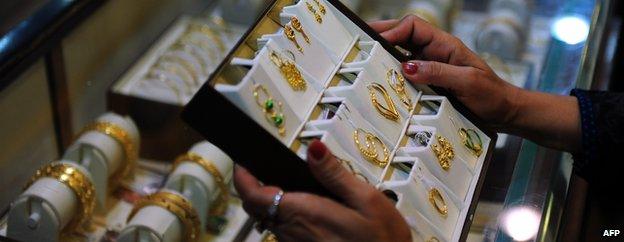India raises duty on gold jewellery imports
- Published

India is the world's biggest consumer of gold and demand for the metal has been rising further
India has increased the duty on imports of gold jewellery to 15% from 10%, in its latest attempt to curb the demand for the precious metal.
Imports of gold jewellery rose after the government increased duties on import of raw gold, including bars and coins, three times this year.
Demand for gold in India has risen after the recent drop in prices.
However, gold imports are also one of the biggest contributors to India's widening current account deficit.
A current account deficit is the difference between inflow and outflow of foreign currency and it occurs when a country's total imports are greater than its exports.
A widening deficit strains the country's foreign exchange reserves, as well as the value of its currency.
India has been trying to bring down the deficit after it hit a record high of 6.7% of its gross domestic product (GDP) in the October-to-December quarter last year.
Protecting domestic industry
India is the biggest consumer of gold in the world.
The precious metal is seen by many consumers as a secure investment, while the festive season results in a surge for demand for jewellery.
The government has been trying to rein in the growing demand. It has raised the import duty on raw gold three times this year - the latest increase taking the duty to 10%.
However, that resulted in imports of jewellery rising, as it had left the duties on that segment unchanged.
India's finance ministry said: "There is an apprehension that Indian jewellery makers would not be able to compete with cheaper imports, particularly when the majority of the imported jewellery is machine-made, as compared to handmade jewellery in India."
It added that it was raising the duty on jewellery to "protect the interests of small artisans".
Haresh Soni, chairman of the All India Gems and Jewellery Trade Federation, said: "This is a good move for the local industry and it will support the manufacturing sector."
- Published30 August 2013
- Published6 June 2013
- Published1 April 2013